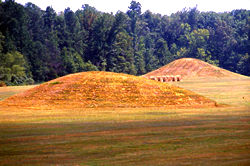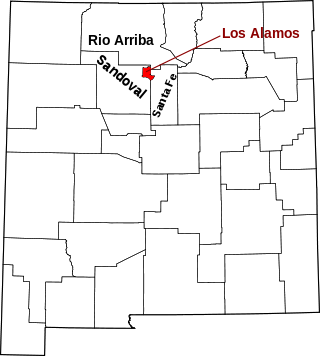Alamo Hueco Site | |
| Nearest city | Animas, New Mexico |
|---|---|
| Area | 40 acres (16 ha) |
| MPS | Animas Phase Sites in Hidalgo County MPS |
| NRHP reference No. | 92001800 [1] |
| NMSRCP No. | 1329 |
| Significant dates | |
| Added to NRHP | January 28, 1993 |
| Designated NMSRCP | October 24, 1986 |
The Alamo Hueco Site is a prehistoric archaeological site in Hidalgo County, New Mexico. The site was inhabited from 600 to 1350 A.D., a period which spanned the San Luis phase, the Mimbres phase, and the Animas phase. The inhabitants of the site built several adobe mounds; while the mounds have been extensively vandalized, two large mounds still contain hundreds of rooms and significant cultural deposits. Materials recovered from the site include ceramics, lithic scatters, and cobbles. [2]
The site was added to the National Register of Historic Places on January 28, 1993. [1]

Bandelier National Monument is a 33,677-acre (13,629 ha) United States National Monument near Los Alamos in Sandoval and Los Alamos counties, New Mexico. The monument preserves the homes and territory of the Ancestral Puebloans of a later era in the Southwest. Most of the pueblo structures date to two eras, dating between 1150 and 1600 AD.

Hueco Tanks is an area of low mountains and historic site in El Paso County, Texas, in the United States. It is located in a high-altitude desert basin between the Franklin Mountains to the west and the Hueco Mountains to the east. Hueco is a Spanish word meaning hollows and refers to the many water-holding depressions in the boulders and rock faces throughout the region. Due to the unique concentration of historic artifacts, plants and wildlife, the site is under protection of Texas law; it is a crime to remove, alter, or destroy them.

Wickliffe Mounds is a prehistoric, Mississippian culture archaeological site located in Ballard County, Kentucky, just outside the town of Wickliffe, about 3 miles (4.8 km) from the confluence of the Ohio and Mississippi rivers. Archaeological investigations have linked the site with others along the Ohio River in Illinois and Kentucky as part of the Angel phase of Mississippian culture. Wickliffe Mounds is controlled by the State Parks Service, which operates a museum at the site for interpretation of the ancient community. Listed on the National Register of Historic Places, it is also a Kentucky Archeological Landmark and State Historic Site.

This is a list of properties and districts in Illinois that are on the National Register of Historic Places. There are over 1,900 in total. Of these, 85 are National Historic Landmarks. There are listings in all of the state's 102 counties.
This National Park Service list is complete through NPS recent listings posted July 28, 2023.

This is a list of properties and districts in New Mexico that are on the National Register of Historic Places. There are more than 1,100 listings. Of these, 46 are National Historic Landmarks. There are listings in each of the state's 33 counties.

The original Franciscan mission, Nuestra Señora de la Concepción del Socorro, was founded in 1682 by the Franciscan order, to serve displaced Spanish families, American Indians from New Mexico, who fled the central New Mexico region during the Pueblo Revolt. The present Socorro Mission was constructed around 1839 to replace an earlier 18th-century mission destroyed in 1829 by flooding of the Rio Grande. The mission, constructed of adobe surfaced with stucco, is particularly notable for its interior. The finely painted and decorated beams, or vigas, are from the 18th-century mission and were reused when the present church was constructed. The massing, details and use of decorative elements of the Socorro Mission show strong relationships to the building traditions of 17th-century Spanish New Mexico.

The Menard–Hodges site (3AR4), is an archaeological site in Arkansas County, Arkansas. It includes two large platform mounds as well as several house mounds. It is the type site for the Menard phase, a protohistoric Mississippian culture group.

The Emerald Mound site, also known as the Selsertown site, is a Plaquemine culture Mississippian period archaeological site located on the Natchez Trace Parkway near Stanton, Mississippi, United States. The site dates from the period between 1200 and 1730 CE. It is the type site for the Emerald Phase of the Natchez Bluffs Plaquemine culture chronology and was still in use by the later historic Natchez people for their main ceremonial center. The platform mound is the second-largest Mississippian period earthwork in the country, after Monk's Mound at Cahokia, Illinois.

The Rabbit Ears are a pair of mountain peaks in northeastern New Mexico, United States, 8 kilometres (5.0 mi) north of the city of Clayton. The two peaks were a distinctive landmark along the Cimarron Cutoff of the Santa Fe Trail, a major route for westbound settlers in the 19th century. The formation was designated a National Historic Landmark in 1963.The name is that of a Native American chief who was killed here in a battle with the Spanish in 1717.

This is a list of the National Register of Historic Places listings in Hidalgo County, New Mexico.

The C.H. Nash Museum at Chucalissa is located on and exhibits excavated materials of the Mississippian culture archaeological site known as Chucalissa which means "abandoned house" in Chickasaw. The site is located adjacent to the T. O. Fuller State Park within the city of Memphis, Tennessee, United States. Chucalissa was designated National Historic Landmark in 1994 due to its importance as one of the best-preserved and major prehistoric settlement sites in the region.

The Alamo Hueco Mountains are a 15-mile (24 km) long mountain range, located in the southeast of the New Mexico Bootheel region, southeast Hidalgo County, New Mexico, adjacent to the border of Chihuahua state, Mexico. The range lies near the southern end of the mountains bordering the extensive north–south Playas Valley; the Little Hatchet and Big Hatchet Mountains are adjacent, and mostly attached north; the mountain range series, ends south into the flatland plains of the Chihuahuan Desert. The much smaller Dog Mountains are adjacent south.

Pharr Mounds is a Middle Woodland period archaeological site located near Tupelo in parts of Itawamba and Prentiss counties in northern Mississippi. This complex was made of earthwork mounds.

This is a list of the National Register of Historic Places listings in Los Alamos County, New Mexico.
Blair Mound is a historic archaeological site located near Winnsboro, Fairfield County, South Carolina. Blair Mound is an earthen mound structure in the form of a low, oval hummock. It measures approximately 75 by 50 yards and is just over 5 feet (1.5 m) high, with evidence of leveling for agricultural development.
The Box Canyon Site is a prehistoric archaeological site in Hidalgo County, New Mexico. The site was occupied during the Animas phase (1200–1350); some artifacts may also date from the Salado phase (1350–1450) The principal feature of the site is an adobe house mound containing more than 100 rooms. A 1962 excavation explored 18 of the rooms; artifacts recovered from the investigation include ceramics, stone and metal flakes, and some cobbles.
Archeological Site No. LA 54050 is a prehistoric archaeological site in Hidalgo County, New Mexico. The Animas phase site was inhabited from roughly 1200 to 1350 A.D. Its principal feature is a 1-metre tall adobe mound with about 50 rooms. Another adobe block to the south of the main mound may contain another 50 rooms, though it has not been fully investigated. A lithic scatter is located to the west of the main site. Artifacts recovered from the site include ceramics, cobbles, and projectile points.
Archeological Site No. LA 54049 is a prehistoric archaeological site in Hidalgo County, New Mexico. The site was inhabited during the Animas phase ; it may have also had a Mimbres phase occupation in 1000-1150 A.D. The site's most distinctive feature consists of two stone lines, each roughly 30 metres (98 ft) long and separated by a 29-metre (95 ft) gap. While the purpose of the lines is uncertain, they may have demarcated a court for some sort of ball game. The site also includes a large lithic scatter and numerous ceramic fragments.
Archeological Site No. LA 54042 is a prehistoric archaeological site in Hidalgo County, New Mexico. The site was inhabited during the Animas phase ; some artifacts may also date from the Salado phase A small adobe structure with one to three rooms sits on the east side of the site; it is surrounded by scattered cobbles and ceramics. The structure's small size suggests that it was used as some sort of temporary building, possibly as a field house. The remainder of the site consists of dispersed lithic shards with a relatively low density.
Archeological Site No. LA 54021 is a prehistoric archaeological site in Hidalgo County, New Mexico. The site dates from the Animas phase, which spanned from 1200-1350 A.D. Adobe structures with at least 16 total rooms have been found at the site; these structures may represent a transitional phase between pit dwellings and larger Animas compounds. Six of these rooms are filled in with soil and retain their cobble foundations and parts of their adobe walls. The site also includes ceramic remains and some stone artifacts.